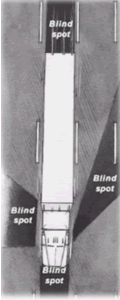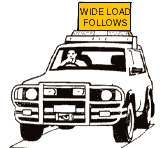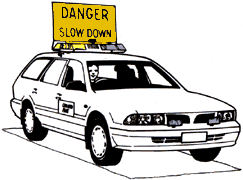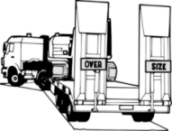Vehicles of many sizes share New Zealand’s road network, but they don’t always share it safely.
Every year around 44 people die as a result of crashes between trucks and cars or motorcycles, and a further 488 people are injured.*
Although motorists sometimes blame these crashes on 'truckies who think they own the road', in most cases it is the car driver or motorcyclist who is at fault.
Part of the problem is that many motorists just aren't aware of the potential hazards that exist when big and small vehicles share the road.
The more that car drivers and motorcyclists know about the limitations of trucks and how they should drive when they encounter them, the more crashes may be prevented.
So, what can you do to share the road more safely with trucks? Motorists who follow these guidelines in this factsheet can help ensure a safer journey for themselves, their passengers, and other road users.
*Note: Crash data for 2019 is not yet complete. Data is for all crashes reported by the Police to the NZ Transport Agency for the year 2019 as recorded in CAS at 11/05/2020.
Follow these guidelines when you encounter trucks on the road.
In good road and weather conditions, you should leave a gap of at least three seconds between your vehicle and the truck in front of you – and an even greater gap when conditions are poor. This will prevent road spray picked up by the truck's wheels from affecting your visibility. Also, the truck may block your view of the road ahead, so hanging back will increase your field of vision and give you more stopping distance if the truck brakes suddenly to avoid a hazard you can't see.
Because of the size of trucks, the view other drivers have of you may be restricted. At intersections and in slow traffic, ensure you stay far enough back for other drivers to see you. This is particularly important for motorcyclists.
When following at night, keep your headlights on low beam. The truck's many side mirrors will reflect high beam lights right into the driver's eyes.
Close
Trucks have a big blind spot directly behind them, so it's a good idea to position your vehicle so it can be seen in the truck's side mirrors. This will let the truck driver know you are there – drivers can then give you plenty of warning when they intend to stop or turn. Remember to keep an eye on the truck's brake lights and turning indicators.
CloseTrucks have large blind spots on both sides – but especially on their left. On multi-lane roads or when overtaking, try to avoid these blind spots, or keep the time you spend in them to a minimum. If a truck driver decides to change lanes or make a turn while your vehicle is in one of these blind spots, a serious crash could occur.
Remember: if you can't see the truck driver in their side mirror, the truck driver can't see you!
CloseBe patient when waiting to overtake a truck. It takes several seconds longer to pass a truck on a level road than it does to pass a car, so it's more important than usual to make sure there's plenty of clear road ahead so you can safely complete the overtaking manoeuvre.
Don't be annoyed if the truck is keeping close to the centre line. The truck driver isn't doing this to stop you from passing – they're probably trying to avoid overhanging trees or the broken, uneven edges of the road.
Don't come too close to the back of the truck before you move out to overtake. As well as limiting your visibility and the truck driver's ability to see your vehicle, you may not get an accurate impression of the strength of the head wind. Also, you'll be driving in an area of low pressure that 'sucks' your vehicle along, making it seem as though it has more engine power available than it actually does.
It's important to give yourself enough room to build up speed – but remember to keep your speed to a level that is safe for the conditions. You also need to give yourself enough room to return to your lane if there's an oncoming hazard.
Make sure you indicate, so the truck driver knows you intend to pass. As you pass the truck, be aware that air turbulence could affect your vehicle's behaviour. Motorcycles and small cars are particularly affected by the air turbulence around large vehicles.
Unless it's an emergency, don't return to your lane until the whole of the front of the truck is visible in your rear-view mirror. Trucks can have blind spots extending several metres in front of them, so truck drivers may not be able to see your vehicle if you cut in too close. Maintain your speed so the truck isn't forced to brake abruptly.
When passing a stationary truck, lower your speed in case the truck driver steps onto the road.
CloseAt 90km/h, it will generally take a truck-trailer unit more than twice as far to stop as it would take a car, because of the truck-trailer unit's weight and the design of its brakes. Any motorist who cuts in front of a truck and suddenly slows or stops is at risk of causing a serious rear-end crash. Even if the truck driver manages to avoid a collision by swerving or braking quickly, this may cause a dangerous load shift which itself may lead to a crash.
You can help truck drivers by leaving them plenty of braking space and by indicating sooner before you turn, change lanes or brake.
CloseTrucks often need to cross the centreline when turning a corner – particularly when they're making a left turn. A truck turning left may initially move to the right to give itself more room to complete the turn. A motorist can make the mistake of thinking the truck is turning right, and may try to overtake the truck on the left. When the truck turns left, the motorist's vehicle will crash into the truck's side.
It's important to look at a truck's indicators – not just its movements.
Never try to pass a truck while it is turning.
This includes passing on the right, too, because the back end of a truck can intrude across the lane during a turn.
If you are stopped at an intersection and a truck is turning into the oncoming lane, you may want to back up or pull closer to the side of the road to give the truck more room.
CloseThe size of some trucks means they cannot avoid blocking the road when they reverse into a driveway or side street. Never try to drive around the rear of the truck when it is reversing or preparing to reverse. You'll be entering one of the truck's blind spots and risk being backed into. Also, the truck may be concealing a hazard on its other side.
CloseWhen passing an oncoming truck, keep firm control of the steering wheel to counter the effect of air turbulence.
If you're a motorcyclist, move to the left of your lane to avoid the worst of the turbulence, but not so far that you risk being blown off the road. Also change down a gear, so the bike has enough power to accelerate and steer into the wind gust.
At night, it's a good idea to dip your lights sooner than you normally would when going over the top of a hill, to prevent dazzling truck drivers coming from the opposite direction.
CloseTravelling behind or alongside trucks in wet conditions can be tricky. Splash and spray is thrown out and can make it difficult for you to see clearly.
While trucks have a covering system – usually mudguards and mudflaps – to reduce the amount of spray and road debris thrown out from under their wheels, this does not prevent spray being thrown out from the sides and rear of the truck. Many motorists consider this to be a nuisance and a danger, but unfortunately, there is no equipment available that could solve this problem effectively. However, there are some things you can do when driving in wet conditions behind or alongside a truck to help increase your safety:
Keep the windscreen clean and the windscreen wipers and washers in good condition. This will help ensure you have a clear view.
If approaching an oncoming truck, turn on your wipers just before it passes you. This will ensure your windscreen is wiped as soon as any spray is thrown onto it, and the time your visibility is obscured will be reduced.
Don't pull out to pass a truck unless you can clearly see your way forward.
Slow down so the distance between you and the truck increases. This will get you back into clearer air and reduce the stress brought on by driving in difficult conditions.
Meeting an oversize vehicle, or a vehicle with an oversize load, is a situation that demands caution, care and common sense.
An oversize vehicle or load is one that exceeds the normal maximum dimensions for vehicles operating on the road in New Zealand.
Oversize vehicles and loads vary greatly in size, from those that are only slightly larger than normal sized trucks, to extremely large loads that can block the entire road.
Oversize vehicles and loads are allowed to travel on New Zealand roads because they play an important role in the country's economy. To minimise disruptions and ensure the safety of other road users, they are subject to special operating conditions.
Next we'll look at the measures that are used to identify oversize vehicles and loads, and to help motorists manoeuvre around them safely.
CloseAn oversize vehicle may be wide, high, long, or any combination of the three. It will display the OVERSIZE sign.
Close
Smaller oversize vehicles and loads usually travel on their own.
Larger oversize vehicles and loads must be escorted by a pilot vehicle. Pilot vehicles have revolving lights and more specific signs warning about the oversize vehicle or load that follows.
Extremely long or wide oversize vehicles or loads are relatively rare. They may have two pilot vehicles in front and a rear pilot vehicle behind. The pilot vehicles will be in constant communication with each other.
Signs and lights that pilot vehicles display:

If the load that follows is very wide, the pilot vehicle will have revolving amber lights on the roof and a sign reading:

If the load that follows is very long, the pilot vehicle will have revolving amber lights on the roof and a sign reading:

If the load that follows is extremely large, the front pilot vehicle will have amber and purple revolving lights on the roof, purple flashing lights on the front, flashing headlights and a large sign reading DANGER: SLOW DOWN.
The second pilot vehicle will be closer to the oversize load. It will have a WIDE LOAD FOLLOWS warning sign.
Close
When you see an oversize vehicle or load coming towards you, slow down.
If there is no pilot vehicle in front of the oversize vehicle, reduce your speed as soon as you see the OVERSIZE sign. Keep your speed down and be prepared to pull over, if necessary, until the vehicle or load has passed by.
If a pilot vehicle is in front of the oversize vehicle or load, you must take extra care when allowing it to pass by. Co-operate with the driver of the pilot vehicle if you are signalled to pull over.
The law requires you to make way and, if necessary, stop to allow an oversize vehicle or load to pass by safely.
The oversize vehicle or load may need to use the centre of the road to safely clear roadside structures and parked cars.
Extremely large oversize vehicles or loads are usually moved late at night or very early in the morning, when few motorists are on the road. If you see a pilot vehicle with flashing purple and amber lights and a DANGER sign, the load it precedes will be extremely large and will be escorted by a second pilot vehicle. Obey the instructions of the pilot drivers, as the road may be completely blocked by the oversize load.
If the pilot vehicle displays a handheld 'stop' sign, you are required by law to stop and obey any instructions that are given.
The drivers will signal you to stop with a portable STOP sign or a red flag during daylight hours, or with a red torch at night.
Close
The large size and slow speed of oversize vehicles means that extra care is needed when overtaking.
If you see the OVERSIZE sign on the back of a truck, slow down and be patient. The oversize vehicle should pull over, when it can, to let you pass.
When a rear pilot vehicle trails a load, it will display a warning sign. If the driver of the rear pilot vehicle waves you through, you may overtake. Pass the rear pilot vehicle and the oversize load in one manoeuvre if possible.
You are then likely to encounter one or two pilot vehicles in front of the truck. These vehicles are likely to be travelling slowly. Overtake them when it is safe to do so.
CloseSerious concerns about the operation of oversize vehicles or loads should be reported to your nearest branch of the police. Provide as many details as possible, including registration numbers and the name of the firm moving the vehicle or load.
Close